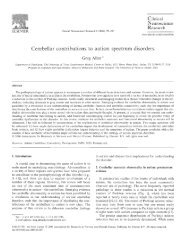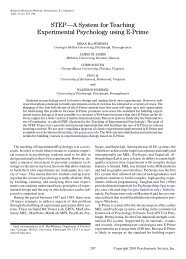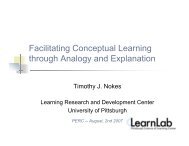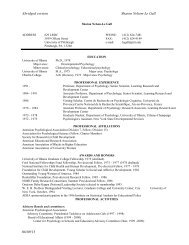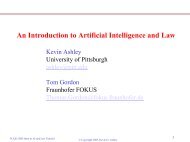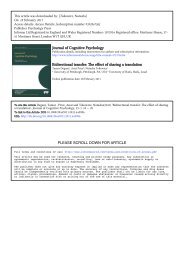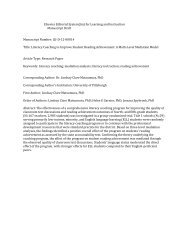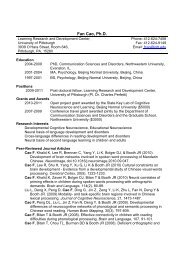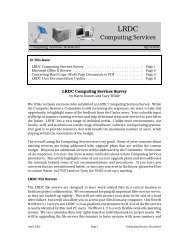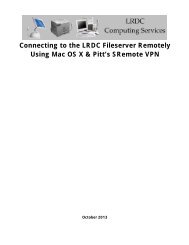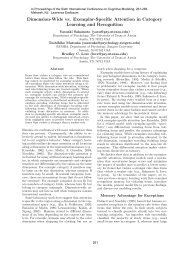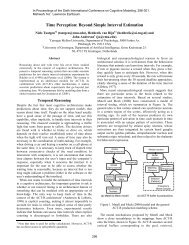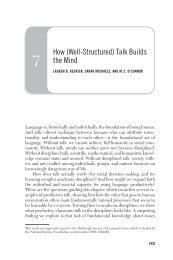Nested Learning Systems for the Thinking Curriculum
Nested Learning Systems for the Thinking Curriculum
Nested Learning Systems for the Thinking Curriculum
You also want an ePaper? Increase the reach of your titles
YUMPU automatically turns print PDFs into web optimized ePapers that Google loves.
FIGURE 1. Criteria and expectations of literacy from <strong>the</strong> 17th to<strong>the</strong> 21st centuries. Adapted from D. P. Resnick & L. B. Resnick(1977). The nature of literacy: An historical exploration. HarvardEducational Review, 47(3), 370–385.United States at <strong>the</strong> turn of <strong>the</strong> 20th century. In 1892, <strong>the</strong>Committee of Ten, a working group of educators from collegesand universities across <strong>the</strong> country, attempted to create <strong>for</strong> <strong>the</strong>first time a curriculum plan <strong>for</strong> all students who attendedAmerican high schools (Hertzberg, 1988). The program that <strong>the</strong>committee agreed on included <strong>the</strong> recommendation to teachEnglish, math, and history or civics to every student in everyacademic year, along with recommendations <strong>for</strong> specific coursesequences. With expectable debate and quarrels about whichschools really counted as high schools and what “all” studentsshould be expected to learn, <strong>the</strong> committee’s program graduallybecame <strong>the</strong> core curriculum <strong>for</strong> American secondary students.Yet by 1910 only about 10% of students attended school beyond<strong>the</strong> eighth grade. So <strong>the</strong> Committee of Ten curriculum is perhapsbest thought of as America’s response to Europe’s elite technicalschools.The proportion of students attending secondary school in <strong>the</strong>United States rose only very slowly over <strong>the</strong> succeeding decades.At <strong>the</strong> century’s midpoint, roughly two thirds of <strong>the</strong> school-agepopulation was in high school. Thus <strong>the</strong> “common core” program<strong>for</strong> high school a century ago reached many fewer studentsthan today participate in our college preparatory high school programs.A rough estimate of literacy levels in <strong>the</strong> United States in1900 (see central point in Figure 1) suggests that only about halfof young people were completing eighth grade. Those who did sowere literate at higher levels than <strong>the</strong> mass of 17th- and 18thcenturypupils but fell well short of <strong>the</strong> elite standard that <strong>the</strong>Committee of Ten was attempting to codify.Today we are aiming <strong>for</strong> something new in <strong>the</strong> world: An elitestandard <strong>for</strong> everyone (star at top right of <strong>the</strong> Figure 1 graph). Thatis what <strong>the</strong> term 21st-century skills really means. The skills are notnew (some students have been successfully learning <strong>the</strong>m in someschools from <strong>the</strong> beginning of civilization). But <strong>the</strong> aspiration tosuccessfully teach knowledge-grounded reasoning competenciesto everyone is still just that—an aspiration. Is it a sensible one? Is<strong>the</strong>re any reasonable prospect of meeting it? What would it take?Those are <strong>the</strong> questions I aim to answer in this essay. To anticipate,I will argue that basic human capacity <strong>for</strong> learning and thinkingmakes <strong>the</strong> aspiration humanly possible, if we think in terms of<strong>the</strong> learning capabilities of most individuals. But <strong>the</strong> trans<strong>for</strong>mationof <strong>the</strong> institution of schooling that will be needed to comeclose to making <strong>the</strong> aspirational goal a real achievement is huge.I will suggest some steps we might take in <strong>the</strong> near future. To dothis, I will take <strong>the</strong> reader on a quick journey through a slice ofnational achievement data from <strong>the</strong> past two decades and a summaryof a consensual cognitive science–based <strong>the</strong>ory of instructionthat most scholars of learning and teaching now agree on.I will <strong>the</strong>n examine systems engineering and social science conceptsthat point toward a new foundation <strong>for</strong> policies and practicesthat may radically improve <strong>the</strong> proportion of students whocan achieve true 21st-century skills.Reaching <strong>for</strong> <strong>the</strong> Star: Caught in <strong>the</strong> Basics TrapFrom <strong>the</strong> 1990s on, <strong>the</strong> public agenda of raising educational levels<strong>for</strong> all has been promoted under <strong>the</strong> banner of <strong>the</strong> standards movement,often accompanied by <strong>the</strong> phrase “All children can learn.”But nei<strong>the</strong>r term clarifies just what we have expected all childrento learn and thus what <strong>the</strong> standards ought to be. The evidence isnow pretty clear. We seem to have figured out how to teach “<strong>the</strong>basics” to just about everyone—with special success in ma<strong>the</strong>matics.But we are deeply unsuccessful in <strong>the</strong> rest of our 21st-centuryagenda of moving beyond basic competencies to proficiency.Figure 2 shows <strong>the</strong> National Assessment of EducationalProgress (NAEP) fourth-grade math scores over an 18-yearperiod spanning <strong>the</strong> end of <strong>the</strong> 20th and <strong>the</strong> beginning of <strong>the</strong>21st centuries. The graph plots scores separately <strong>for</strong> Whites,Blacks, and Hispanics. There has been a nearly continuous rise inachievement scores over this period among all population groups.The achievement gap has not closed, but it has shrunk somewhat.In fact, and very much worth noting, Blacks and Hispanics weredoing as well in 2007 as Whites had been in 1990. The fourthgrademath gap would have closed completely if White studentshad not continued to improve across <strong>the</strong> 18-year period! Ineighth-grade math, <strong>the</strong> pattern is similar (Figure 3), with Blacksshowing an especially steep rise, but a lower percentage ofstudents is meeting basic eighth-grade goals.The story is less dramatic <strong>for</strong> reading, but <strong>the</strong>re is evidencethat this achievement gap is shrinking somewhat as well. Over<strong>the</strong> past 20 years, guided by a growing body of scientific research,<strong>the</strong>re has been substantially more teaching of <strong>the</strong> components ofbasic literacy (phonemic awareness, phonics, vocabulary). Andthis has shown up in higher first-grade scores on basic worddecoding skills (National Institute <strong>for</strong> Literacy, 2008). But byfourth grade, when NAEP first measures reading, <strong>the</strong> focus is onreading comprehension—understanding what you read. There,<strong>the</strong> gains have been very small.Overall, <strong>the</strong>n, national achievement results suggest that as anation we are en route to eliminating basic illiteracy and innumeracy.The really troubling per<strong>for</strong>mances of <strong>the</strong> early 1990s, in184educational ResearcherDownloaded from http://er.aera.net at UNIV OF PITTSBURGH on March 30, 2012
FIGURE 2. Disaggregated NAEP scores <strong>for</strong> 1990 through 2007, fourth-grade ma<strong>the</strong>matics. Source: U.S. Department of Education,Institute of Education Sciences, National Center <strong>for</strong> Education Statistics, National Assessment of Educational Progress (NAEP), NAEP DataExplorer, available online at http://nces.ed.gov/nationsreportcard.FIGURE 3. Disaggregated NAEP Scores <strong>for</strong> 1990 through 2007, eighth-grade ma<strong>the</strong>matics. Source: U.S. Department of Education,Institute of Education Sciences, National Center <strong>for</strong> Education Statistics, National Assessment of Educational Progress (NAEP), NAEP DataExplorer, available online at http://nces.ed.gov/nationsreportcard.which large numbers of our minority students, along with someWhite children of poverty, seemed to be fundamentally illiterateor innumerate, have changed. We are on <strong>the</strong> way to meeting our“basic education” goals—and we have achieved this even as wehave absorbed growing numbers of students with limited Englishproficiency into <strong>the</strong> nation’s schools. It appears that <strong>the</strong> standardsef<strong>for</strong>t, including requirements <strong>for</strong> disaggregated test score reporting,is having <strong>the</strong> hoped-<strong>for</strong> equity effects. We are teaching basicliteracy and math to more and more of our elementary schoolchildren, and fewer and fewer are being left way behind.We are, however, very far from reaching <strong>the</strong> star. Proficiencylevels on <strong>the</strong> NAEP remain low, and <strong>the</strong>re are very few students ofany subgroup reaching Advanced levels. Fur<strong>the</strong>rmore, it now seemslikely that <strong>the</strong> accountability regime that appears to be creatingmuch of <strong>the</strong> improvement in Basic skills may actually be limitingprogress toward <strong>the</strong> kinds of more challenging competencies weseek. The effects of high-stakes, low-cognitive-demand tests oninstructional practice have been quite widely documented bynow (Koretz & Hamilton, 2006; McNeill, 2002). Most studiesshow that state tests have led to a noticeable increase in <strong>the</strong> amountof instructional time devoted to <strong>the</strong> tested subjects and a correspondingdrop in nontested subjects (Center on Education Policy,2008). Most districts that increased time <strong>for</strong> English languagearts or ma<strong>the</strong>matics also reported substantial cuts in time <strong>for</strong>o<strong>the</strong>r subjects, including social studies, science, art and music, andphysical education (Center on Education Policy, 2008).Even within <strong>the</strong> tested subjects, it appears that test-basedaccountability may be narrowing what is taught. In many urbanschool districts, teachers are emphasizing test preparation overo<strong>the</strong>r aspects of <strong>the</strong>ir districts’ official curricula (Shepard, 2002–2003). As end-of-year testing dates approach, teaching time isspent on test practice. In one district that we have studied intensively,elementary students stop reading and discussing gradelevel-appropriatebooks in February and instead spend timeDownloaded from http://er.aera.net at UNIV OF PITTSBURGH on March 30, 2012april 2010 185
FIGURE 6. Three-level conceptual model of K–12 district system with process feedback. Source: L. B. Resnick, M. Besterfield-Sacre, M. M.Mehalik, J. Z. Sherer, and E. R. Halverson. (2007). A framework <strong>for</strong> effective management of school system per<strong>for</strong>mance. In P. A. Moss (Ed.),Evidence and decision making: The 106th yearbook of <strong>the</strong> National Society <strong>for</strong> <strong>the</strong> Study of Education (NSSE) (Part I, pp. 155–185).Malden, MA: Blackwell.To <strong>the</strong> left in Figure 7 are hypo<strong>the</strong>sized enablers (sometimesconstraints) that <strong>the</strong> school or district introduces (some of <strong>the</strong>processes fall between district and school or between school andclassroom). The research basis <strong>for</strong> <strong>the</strong> elements fur<strong>the</strong>r to <strong>the</strong> leftin <strong>the</strong> diagram is much thinner than <strong>for</strong> classroom processes, but<strong>the</strong>re is widespread agreement in <strong>the</strong> policy making and policyresearch communities that each of <strong>the</strong> elements named is potentiallyimportant. In fact, many proposed policy initiatives arebased on assumptions involving <strong>the</strong>se elements (e.g., hire andreward teachers with more knowledge and skill, provide continuingprofessional development, modify principal hiring and schoolassignment policies).To check our hypo<strong>the</strong>sized process model against <strong>the</strong> implicitmodels of leaders in urban school districts, we invited key decisionmakers in several urban school districts to participate in aseries of mapping exercises. More than 100 urban district officials(including superintendents, deputy superintendents, chiefacademic officers, instructional supervisors, and principals) participated.Participants were given a set of “tiles,” each containingone of <strong>the</strong> elements in Figure 7. They were permitted to discardany elements <strong>the</strong>y did not deem centrally important and to addnew ones, if necessary, to reflect <strong>the</strong>ir views. Participants wereasked to create “influence maps” of <strong>the</strong>ir policies aimed atimproving student learning. Twenty-eight groups of district officialscreated 28 different maps using our organizational elementsand enablers plus a small number of additional ones that<strong>the</strong>y added.Although <strong>the</strong>re were variations among <strong>the</strong> maps, certaincharacteristics were largely shared. First, our hypo<strong>the</strong>sized systemelements did, according to our participants, constitute <strong>the</strong>fundamentals of <strong>the</strong> K–12 system. Even though district leaderswere instructed to add additional elements as needed, fewwere added, and <strong>the</strong>re was no consistency among <strong>the</strong> additions.In addition, <strong>the</strong> pattern of influence revealed in <strong>the</strong> 28separate practitioner maps was quite similar to what is shownin Figure 7.We combined <strong>the</strong> qualitative knowledge embodied in our districtexperts’ graphs using an algorithmic approach involving arecursive path-counting routine written in VB.NET (Clark,Sherer, Besterfield-Sacre, & Resnick, 2007). The results of <strong>the</strong>VB.NET analyses identify frequently occurring paths among <strong>the</strong>28 maps developed by our school district participants. Thesepaths represent prominent shared <strong>the</strong>ories of action among ourexperts <strong>for</strong> how to influence classroom processes to produceimproved student learning. Four high-frequency two-elementpaths were identified:Instructional leadership → teacher beliefsQuality of professional community → teacher beliefsProfessional development → teacher knowledge and skillSchool calendar → instructional scheduleFur<strong>the</strong>r, four individual elements (instructional leadership,quality of professional community, teacher beliefs, teacherDownloaded from http://er.aera.net at UNIV OF PITTSBURGH on March 30, 2012april 2010 189
FIGURE 7. Fundamental elements of <strong>the</strong> K–12 system according to participant practitioners.knowledge and skill) also appeared in frequently identified pathsof three, four, or five elements. All 28 groups placed teacherbeliefs in <strong>the</strong>ir diagrams. All but one included teacher knowledgeand skill. Instructional leadership, quality of professional community,and professional development were used with high frequency.Thus, according to our participants, <strong>the</strong>re is a solid coreof processes essential to enabling <strong>the</strong> classroom practices that weknow produce student learning.Policy Planning: The New Re<strong>for</strong>m TriangleAlthough <strong>the</strong> terms human capital and social capital had deliberatelynot been used in our mapping exercises (to avoid havingtechnical terms block our experts’ ability to articulate <strong>the</strong>ir own<strong>the</strong>ories of action), <strong>the</strong> education leaders we worked with shared<strong>the</strong> underlying ideas expressed by those terms. Our participantsaffirmed <strong>the</strong> importance of organizational features of schools thatsocial scientists and policy experts have been addressing <strong>for</strong> sometime: human capital (expressed as “teacher knowledge and skill,”“teacher beliefs,” and “instructional leadership”) and social capital(expressed as “quality of professional community” and “ef<strong>for</strong>tbasedinstructional culture”). To <strong>the</strong>se two terms, we add a third:instructional tools and routines (expressed as “appropriate assessmentsavailable,” “curriculum and materials,” “professionaldevelopment”). These three organizational features comprise anew policy triangle (see Figure 8) that is beginning to guide policydesigns <strong>for</strong> improved achievement—although it is rare <strong>for</strong>advocates or scholars to consider <strong>the</strong> three in combination.Human CapitalEconomists tend to be especially interested in human capital:what people in <strong>the</strong> organization know and know how to do(Harbison & Hanushek, 1992). Human capital is typically measuredby credentials, per<strong>for</strong>mance observations, and individualoutputs (in education, student learning). Economists have relatedFIGURE 8. Policy triangle to guide policy design in educationalsettings.190educational ResearcherDownloaded from http://er.aera.net at UNIV OF PITTSBURGH on March 30, 2012
student per<strong>for</strong>mance on academic measures to <strong>the</strong> number andtype of courses teachers have taken in college or graduate school(Boyd, Grossman, Lank<strong>for</strong>d, Loeb, & Wyckoff, 2006, 2008).Some recent work using more refined measures of teacher knowledgealso shows a significant positive relationship between teacherknowledge and student achievement (Hill, Rowan, & Ball, 2005).Our expert educators agreed that teacher knowledge is animportant enabler of <strong>the</strong> kinds of classroom activity that enhancestudent learning, but <strong>the</strong>y included teacher skill in <strong>the</strong>ir definitionof teacher competence—referring to teachers’ abilities to communicatethat knowledge, engage students’ interest, and in generalcreate classroom environments <strong>for</strong> successful learning. Theythus embraced <strong>the</strong> broad view of teacher knowledge introduced byLee Shulman (1987), who distinguished between content knowledgeand pedagogical content knowledge, arguing that both were essentialto good teaching (see also Darling-Hammond & Brans<strong>for</strong>d,2005). Although popular among educators and educationresearchers, it has not proved easy to measure pedagogical contentknowledge in a way that provides empirical evidence of making adifference in student learning. Some progress is now being madeusing structured classroom observations (Grossman & McDonald,2008) and teacher logs (Rowan & Correnti, 2009).The educators in our study also enriched <strong>the</strong> concept ofhuman capital by pointing to teacher beliefs (<strong>the</strong> extent to whichteachers believe <strong>the</strong>ir students can learn at high levels) as ahypo<strong>the</strong>sized producer of greater student learning. And <strong>the</strong>yidentified instructional leadership as an important element inincreasing productivity, thus making <strong>the</strong> quality of school principalsan important part of <strong>the</strong> human capital equation <strong>for</strong> <strong>the</strong>irschools.Much current policy discussion is aimed at remedying <strong>the</strong>human capital gap by processes of selection (including alternativepathways into education careers), retention, dismissal, and differentialpay (National Academy of Education, 2009). Across <strong>the</strong>United States, several experiments are now under way—<strong>for</strong>example, <strong>the</strong> Denver school system’s ProComp pay <strong>for</strong> per<strong>for</strong>mancesystem—linking such incentives to specific training andinstructional programs.Even if many of <strong>the</strong>se policies were widely implemented, however,<strong>the</strong>re would be a long period be<strong>for</strong>e most of <strong>the</strong> teaching andleadership <strong>for</strong>ce in schools would count as highly qualified undernew and more stringent definitions of quality. In <strong>the</strong> interim, oldorganizational practices might actually suppress <strong>the</strong> developmentof <strong>the</strong> new, knowledge-based <strong>Thinking</strong> <strong>Curriculum</strong> that is ourgoal. Thus we will need to consider how to create human capitalwithin education organizations. The two most promising routesappear to be development of social capital within schools andsystematic introduction of instructional tools and routines thathave <strong>the</strong> power to directly change classroom practice and <strong>the</strong>rebyincrease learning.Social CapitalSocial capital is a term introduced by sociologists (Becker, 1964;Coleman, 1988) referring to resources <strong>for</strong> action that inhere in<strong>the</strong> relations or interactions among people—<strong>the</strong> opportunitiesthat some people have, and that organizations can create, <strong>for</strong>acquiring knowledge and o<strong>the</strong>r resources through interactionswith o<strong>the</strong>rs. Social capital is used to refer to social ties and trustfulrelationships (Adler & Kwon, 2002; Nahapiet & Ghoshal, 1998).A number of sociologists studying processes of education re<strong>for</strong>mhave begun to document links between social capital (e.g., groupsof teachers professionally engaged with one ano<strong>the</strong>r within aschool) and <strong>the</strong> <strong>for</strong>ms of knowledge-based thinking that cognitiveand sociocognitive instructional <strong>the</strong>ory recommends (e.g.,Bryk & Schneider, 2002; Frank, Zho, & Borman, 2004;Gamoran et al., 2003; McLaughlin & Talbert, 2001; Newman,1996).Social capital refers to <strong>the</strong> ways in which people in an organizationshare what <strong>the</strong>y know. With whom do <strong>the</strong>y talk? Howopenly or widely do <strong>the</strong>y share in<strong>for</strong>mation—both positive andnegative—about <strong>the</strong>ir work? Do <strong>the</strong>y know or care who hasexpertise? How broad or narrow are <strong>the</strong>ir networks? Our experteducator participants referred to social capital mainly as <strong>the</strong> qualityof professional community within a school and viewed it as aprimary means of building human capital. Social science researchsupports <strong>the</strong>ir practice-honed view. For example, in a large studyof social capital in New York City schools, high social capital (asmeasured by structured surveys) apparently led many competentteachers to stay in schools serving <strong>the</strong> poor, even if <strong>the</strong> teachershad opportunities <strong>for</strong> better paying jobs nearer to <strong>the</strong>ir ownhomes in <strong>the</strong> suburbs (Leana & Pil, 2009).Instructional Tools and RoutinesHuman and social capital are powerful concepts, but <strong>the</strong>y do nottell <strong>the</strong> whole story. As do all organizations, schools functionthrough a set of more or less interconnecting routines—“repetitive, recognizable patterns of interdependent actions,involving multiple actors” (Feldman & Pentland, 2003, p. 113).These routines are critical <strong>for</strong> any organization to function effectivelybecause <strong>the</strong>y provide stability and continuity over time(Feldman, 2000; Feldman & Pentland, 2003; March, 1981;March & Simon, 1958, 1993) and structure action in organizations(Allison, 1971; Gersick & Hackman, 1990). Groups andindividuals in <strong>the</strong> organization develop routines that constitute<strong>the</strong> normal ways in which work gets done. These routines are notalways in <strong>the</strong> official manuals, but <strong>the</strong>y allow members to per<strong>for</strong>msatisfactorily in <strong>the</strong> judgment of clients and supervisors and<strong>for</strong> <strong>the</strong>ir own self-satisfaction. Such routines often involve adaptationto internal and external institutional constraints and mayalso recruit <strong>the</strong> power of in<strong>for</strong>mal “below <strong>the</strong> radar” work groups,as documented by sociocognitive research (Brown & Duguid,2000; Orr, 1996; Resnick, Saljo, Pontecorvo, & Burge, 1997;Suchman, 1996). Research has documented <strong>the</strong> ways in whichorganizational routines, both <strong>for</strong>mal and in<strong>for</strong>mal, frame andenable interactions, provide stability across time, and assist insocializing new organizational members (M. D. Cohen &Bacdayan, 1994; Feldman & Pentland, 2003; Sherer & Spillane,in press; Spillane, Mesler, Sherer, & Croegaert, 2010).What kinds of routines might be introduced into schoolsand school systems that would build <strong>the</strong> human and socialcapital needed? There are several possibilities—ranging frominstructionally based supervision systems to tools and routines<strong>for</strong> instruction. Stated most directly, it probably would help toput curriculum of known effectiveness, along with materialsand procedures <strong>for</strong> classroom implementation, in <strong>the</strong> hands ofteachers.Downloaded from http://er.aera.net at UNIV OF PITTSBURGH on March 30, 2012april 2010 191
Throughout <strong>the</strong> first half of <strong>the</strong> 20th century—when schoolattendance was expanding, people were moving from farm tocity, and American cities were absorbing <strong>the</strong>n-unprecedentednumbers of internal (South to North) and external immigrants—large school districts laid out well-defined curriculum andinstruction plans and expected teachers to follow <strong>the</strong>m. Startingin <strong>the</strong> 1960s, educational tastes changed and large pressuresagainst “industrial” models of education developed. Over <strong>the</strong>three and a half decades since David Tyack (1974) described <strong>the</strong>functioning of centralized school systems as “Tayloristic” (referringto efficiency methods in which teachers were expected toimplement detailed programs of instruction on a strict schedule),<strong>the</strong>re has been a growing rejection of <strong>the</strong> idea of centrally imposedinstructional programs. This has been accompanied by a rhetoricof professionalization of teachers, with <strong>the</strong> implication thatprofessionals should develop <strong>the</strong>ir own instructional plans andprograms.Today, <strong>the</strong> language of professional independence <strong>for</strong> teachersis so widespread that even when school districts attempt to implementsystems of managed instruction as a way of improving educationalprovision <strong>for</strong> underserved populations of students, <strong>the</strong>ymostly cast <strong>the</strong>ir curriculum offerings as guidance <strong>for</strong> teachersra<strong>the</strong>r than as required programs. Textbooks are adopted but oftenused only sporadically. In <strong>the</strong> face of high-stakes accountability <strong>for</strong>student per<strong>for</strong>mance on state tests, most districts offer interimassessments intended to provide guidance on how to meet studentneeds. In many cases, however, <strong>the</strong> actual use of such assessmentsis voluntary. In a recent PEER study of a large Eastern urban schooldistrict, <strong>for</strong> example, teachers reported not regularly using <strong>the</strong>district-supplied teaching materials in math (which <strong>the</strong>y judgedtoo fast paced <strong>for</strong> <strong>the</strong>ir students), and most did not administer <strong>the</strong>voluntary end-of-unit assessments that <strong>the</strong> district supplied.The resistance to curriculum-based solutions is beginning todecline. There is growing evidence that structured instructionaltools and routines <strong>for</strong> using <strong>the</strong>m can be a powerful route to betterteacher per<strong>for</strong>mance and increased student learning. In <strong>the</strong>next section, I report evidence that <strong>the</strong> three elements of <strong>the</strong> newpolicy triangle can be used toge<strong>the</strong>r to meet 21st-century educationre<strong>for</strong>m goals.Using <strong>the</strong> Policy Triangle toImprove Educational ResultsSchool-Based Instructional Tools and RoutinesAlthough school districts have, by and large, been shying awayfrom—or not fully implementing—curriculum-based re<strong>for</strong>m,<strong>the</strong> instruction-based re<strong>for</strong>m strategy has been kept alive inAmerican schools by some of <strong>the</strong> intervention models thatemerged as part of <strong>the</strong> 1990s re<strong>for</strong>m strategy known as comprehensiveschool re<strong>for</strong>m (CSR). In <strong>the</strong> CSR approach, an individualschool uses state, federal, or philanthropic dollars to contractwith an organization (usually a nonprofit, sometimes a <strong>for</strong>-profitor a university group) that provides a defined service program,usually one that includes professional development and o<strong>the</strong>rsupport <strong>for</strong> teachers.The existence of <strong>the</strong>se CSR schools, using a variety of re<strong>for</strong>mmodels, provided <strong>the</strong> opportunity <strong>for</strong> a research group at <strong>the</strong>University of Michigan (Correnti & Rowan, 2007) to comparedifferent re<strong>for</strong>m strategies’ effectiveness in raising studentachievement in elementary schools. The group’s Study ofInstructional Improvement research program compared schoolsusing three different models of school improvement: Success <strong>for</strong>All (SFA), America’s Choice (AC), and <strong>the</strong> Accelerated SchoolsProject (ASP). The first two (SFA and AC) are curriculum-basedmodels in which <strong>the</strong> external “provider” supplied texts and o<strong>the</strong>rteaching materials, specified student grouping and instructionalprocesses in detail, and provided training in specific pedagogicalstrategies. ASP, by contrast, provided structured support to schoolstaff members to develop <strong>the</strong>ir own instructional plans andimplementations around a broadly shared philosophy of learningand teaching. ASP, in o<strong>the</strong>r words, focused on building socialcapital, whereas AC and SFA used instructional tools and routinesas a route to improved student learning.The findings were striking. Using student learning as <strong>the</strong> criterion,<strong>the</strong> curriculum-based approaches (SFA and AC) per<strong>for</strong>medbetter than <strong>the</strong> ASP approach that worked mainly on developingsocial capital. What is more, <strong>the</strong> learning gains were tightly tiedto <strong>the</strong> specific instruction that was <strong>the</strong> focus of <strong>the</strong> program. Eachprogram showed significant effects only <strong>for</strong> <strong>the</strong> core curriculumcomponent it focused on—basic reading skills in <strong>the</strong> case of SFA,writing skills in <strong>the</strong> case of AC. In o<strong>the</strong>r words, well-implementedcurriculum worked, but <strong>the</strong> effects were specific to <strong>the</strong> tools androutines introduced by <strong>the</strong> provider.District-Based Instructional Tools and RoutinesCan <strong>the</strong> instructional tools and routines strategy be used toincrease student learning across a broad swath of schools in adistrict? This is <strong>the</strong> question we addressed in an experimentalstudy conducted in several dozen elementary schools in a largeurban district in <strong>the</strong> Southwest, a district struggling to raiseachievement among a large and growing population of Spanishspeakingimmigrant children (Matsumura, Garnier, & Resnick,in press). The curriculum approach we introduced was based on<strong>the</strong> reading comprehension program Questioning <strong>the</strong> Author(QtA) developed by Isabel Beck and Margaret McKeown (2002).The tools and routines of QtA were introduced by placing dedicatedliteracy coaches into half of <strong>the</strong> schools under study andtraining <strong>the</strong>m using a program called Content-Focused Coaching(CFC).Coaching is a popular intervention in school districts that aretrying to raise achievement. It is, in <strong>the</strong>ory, a <strong>for</strong>m of professionaldevelopment that is school embedded and <strong>the</strong>re<strong>for</strong>e close toinstructional practice. It also—again in <strong>the</strong>ory—uses <strong>the</strong> bestteachers in <strong>the</strong> system to help build skill among <strong>the</strong> larger teaching<strong>for</strong>ce. Using <strong>the</strong> PEER process of specifying expected influences,coaching can be seen as a means of upgrading teachercontent and pedagogical knowledge, along with teacher beliefsabout student ability to learn. As shown in Figure 9, coaching(<strong>the</strong> central diamond) is expected to enhance key enablers ofclassroom practice such as content coverage and quality of classroominteraction, thus leading to gains in student learning.Coaching is rarely enacted according to <strong>the</strong>ory, however.District practices of hiring and assigning coaches, sometimes governedby union contracts, along with job postings and salary192educational ResearcherDownloaded from http://er.aera.net at UNIV OF PITTSBURGH on March 30, 2012
FIGURE 9. Coaching enhances key enablers and is constrained by district policies and practices.policies, often mean that coaches are selected from <strong>the</strong> teachingranks by seniority or preference of principals ra<strong>the</strong>r than by demonstratedcapacity to increase student learning. Coaches’ jobdescriptions are often only vaguely specified. And, reporting usuallyto individual principals who do not have a developed understandingof what to expect from coaches, <strong>the</strong>y are assigned to amyriad of tasks (ranging from supervising testing, serving as substituteteachers, or providing personal teaching to underper<strong>for</strong>mingstudents) and do not have <strong>the</strong> opportunity to develop asystematic coaching relationship with teachers. Figure 9 alsoillustrates how <strong>the</strong> quality of coaching in a school district isdependent on a large set of policies and practices (those to <strong>the</strong> leftof <strong>the</strong> coaching diamond in Figure 9) that are heavily influencedby <strong>the</strong> district central office.In our study of CFC, we enacted a carefully focused programof coaching in upper elementary classrooms teaching readingcomprehension (Matsumura, Sartoris, Bickel, & Garnier, 2009).The program used to train coaches had been developed overseveral years at <strong>the</strong> University of Pittsburgh’s Institute <strong>for</strong><strong>Learning</strong> (Bickel & Artz, 2001). We worked with district administratorsto select demonstrably successful reading teachers to betrained as coaches. We also worked with school principals todevelop agreements that would make it probable that coachesassigned to <strong>the</strong>ir schools would be scheduled <strong>for</strong> regular meetingswith subgroups of teachers, would be allowed to make classroomvisits to individual teachers, and would not have competing workassignments (Matsumura et al., 2009).Twenty-nine of <strong>the</strong> lowest per<strong>for</strong>ming elementary schools, allwith high proportions of English language learners, were randomlyassigned to ei<strong>the</strong>r <strong>the</strong> CFC or a comparison condition.Teachers and principals in both sets of schools responded to periodicsurveys and interviews. There were systematic observationsof classroom text discussions and recording of <strong>the</strong> complexity of<strong>the</strong> texts being used in instruction. Students’ reading test scoreson <strong>the</strong> state accountability tests were tracked over several years.Teachers in <strong>the</strong> CFC intervention schools significantlyincreased participation in coaching focused directly on classroompractice. The quality of <strong>the</strong> text discussions in <strong>the</strong>ir classroomsimproved: The classes read more difficult texts, <strong>the</strong>yactively referred to <strong>the</strong> texts as <strong>the</strong>y discussed <strong>the</strong>m, and <strong>the</strong>teachers used accountable talk (Resnick, Michaels, et al., in press)classroom discourse strategies. Students in <strong>the</strong> CFC schoolsshowed significantly higher reading test scores (effect size = .25after 2 years). The effect was strongest <strong>for</strong> English language learners(Matsumura, Garnier, & Resnick, in press; see Figure 10).Combining Social Capital and Instructional Tools andRoutines in High SchoolsMany scholars of education practice and re<strong>for</strong>m suggest that <strong>the</strong>quality of professional community in schools is tightly associatedwith student achievement. Considerable work has been done todevelop ways of managing schools that are likely to build andsustain professional communities (Loeb, Darling-Hammond, &Luczak, 2005; McLaughlin & Talbert, 2001). Indeed, it is possiblethat <strong>the</strong> successes of curriculum-based whole-school modelsare in part due to <strong>the</strong> professional community commitments thatare evoked by <strong>the</strong> <strong>for</strong>ms of training and support that are part of<strong>the</strong> implementation packages that <strong>the</strong> sponsoring organizationsbuild into <strong>the</strong>ir programs.In 2001, <strong>the</strong> Institute <strong>for</strong> <strong>Learning</strong> began designing and pilotingan intervention program that explicitly combined instructionaltools and routines with professional development strategiesFIGURE 10. Content-Focused Coaching (CFC) schools showedimproved reading test scores.Downloaded from http://er.aera.net at UNIV OF PITTSBURGH on March 30, 2012april 2010 193
FIGURE 11. Pedagogy and content routine.aimed at building professional learning communities (McConachie& Petrosky, 2010). The institute worked in two urban districts: sixhigh schools in Austin, Texas, in which all teachers in <strong>the</strong> four corehigh school disciplines (science, math, history/geography, andEnglish) participated, and schools in <strong>the</strong> Los Angeles UnifiedSchool District in which <strong>the</strong> departments of ma<strong>the</strong>matics and/orEnglish, along with <strong>the</strong>ir principals, agreed to participate.In both districts, intensive professional development led bysubject matter experts was organized around a “spine” of curriculumunits and lessons that were explicitly linked to <strong>the</strong> districts’official curriculum guidance documents. The units and lessonswere designed to educate teachers in high-cognitive-demand<strong>for</strong>ms of classroom instruction. The <strong>for</strong>m of training used wasintended to induce new <strong>for</strong>ms of professional engagement inwhat we have termed a “kerneling process” (Resnick & Spillane,2006; Resnick, Spillane, Goldman, & Rangel, in press) in which<strong>for</strong>mal routines embedded in an institution give rise to a nextgeneration of practices that are kin to <strong>the</strong> externally introducedroutine but not identical to it. Kernel routines are designed todeliberately displace standard routines of practice. Participatingteachers are expected at first to follow <strong>the</strong> new routines quitefaithfully. However, <strong>the</strong> routines have been developed with <strong>the</strong>goal of encouraging new <strong>for</strong>ms of professional interaction thatare consonant with <strong>the</strong> curriculum plan but crafted by <strong>the</strong> participantsto fit <strong>the</strong>ir interactive and learning preferences.The pedagogy and content routine (PCR) begins by engagingteachers in a tightly crafted routine consisting of a specific set ofprofessional development practices. Training and practice ofPCR occurs separately <strong>for</strong> each teaching discipline, but when <strong>the</strong>routine is used <strong>for</strong> several disciplines within a school (as it was inour Austin implementation), substantial “cross-seeding” anddevelopment of a larger institutional change within a school isexpected to occur.Figure 11 depicts how PCR works. Teachers, coaches, andlead teachers first experience <strong>the</strong> sequence of activities describedin column 2. They begin as learners of model lessons taught by atrainer. They <strong>the</strong>n engage in a trainer-led process of “deconstructing”or interpreting what <strong>the</strong>ir learning process has been and <strong>the</strong>role of <strong>the</strong> trainer in evoking <strong>the</strong>ir learning processes. Next (stillin column 2), participants are asked to teach <strong>the</strong> model lesson ora modification of <strong>the</strong>ir own design. They are observed by <strong>the</strong>trainer and o<strong>the</strong>r teachers, and <strong>the</strong>y <strong>the</strong>n participate with <strong>the</strong>observers in an analysis of <strong>the</strong> pedagogy and content of <strong>the</strong>irteaching. Teachers have <strong>the</strong> experience of both observing andbeing observed during this phase of implementation—alwayswith careful attention to <strong>the</strong> content taught and <strong>the</strong> cognitiveprocesses evoked among students. They next modify or adapt <strong>the</strong>lesson <strong>for</strong> future teaching and continue <strong>the</strong> teaching-observinganalyzingsequence. Alternatively, <strong>the</strong>y can ask <strong>for</strong> one or moreadditional model lessons from <strong>the</strong> spine.Even as <strong>the</strong> teacher group cycles through <strong>the</strong> PCR, <strong>the</strong> kernelingprocess is expected to engender new <strong>for</strong>ms of school practice.As shown in column 3, we expect changes in leadership activity,in norms of trust and collaboration, and in specific collaborative194educational ResearcherDownloaded from http://er.aera.net at UNIV OF PITTSBURGH on March 30, 2012
Darling-Hammond, L., & Brans<strong>for</strong>d, J. (Eds.). (2005). Preparing teachers<strong>for</strong> a changing world: What teachers should learn and be able to do.San Francisco: Jossey-Bass.David, J. L., & Greene, D. (2008). Improving ma<strong>the</strong>matics instruction inLos Angeles high schools: Follow up to <strong>the</strong> evaluation of <strong>the</strong> PRISMA PilotProgram. Palo Alto, CA: Bay Area Research Group.Davis, L. E. (1982). Organizational design. In G. Salvendy (Ed.),Handbook of industrial engineering (pp. 2.1.1–2.1.29). New York:John Wiley.Dweck, C. S., & Molden, D. C. (2005). Self-<strong>the</strong>ories: Their impact oncompetence motivation and acquisition. In A. Elliot & C. Dweck(Eds.) Handbook of competence and motivation (pp. 122–140). NewYork: Guil<strong>for</strong>d.Feldman, M. S. (2000). Organizational routines as a source of continuouschange. Organization Science, 11, 611–629.Feldman, M. S., & Pentland, B. T. (2003). Reconceptualizing organizationalroutines as a source of flexibility and change. AdministrativeScience Quarterly, 48, 94–118.Frank, K. A., Zhao, Y., & Borman, K. (2004). Social capital and <strong>the</strong>diffusion of innovations within organizations: The case of computertechnology in schools. Sociology of Education, 77, 148–171.Gamoran, A., Anderson, C. W., Quiroz, P. A., Secada, W. G., Williams,T., & Ashmann, S. (2003). Trans<strong>for</strong>ming teaching in math and science:How schools and districts can support change. New York: TeachersCollege Press.Gersick, G. J., & Hackman, J. R. (1990). Habitual routines in taskper<strong>for</strong>minggroups. Organizational Behavior and Human DecisionProcess, 47, 65–97.Grossman, P., & McDonald, M. (2008). Back to <strong>the</strong> future: Directions<strong>for</strong> research in teaching and teacher education. American EducationalResearch Journal, 45, 184–205.Harbison, R., & Hanushek, E. (1992). Educational per<strong>for</strong>mance <strong>for</strong> <strong>the</strong> poor:Lesson from rural nor<strong>the</strong>ast Brazil. Ox<strong>for</strong>d, UK: Ox<strong>for</strong>d University Press.Hertzberg, H. (1988). Foundations. The 1982 Committee of Ten. SocialEducation, 52(2), 44–45.Hill, H., Rowan, B., & Ball, D. (2005). Effects of teachers’ ma<strong>the</strong>maticknowledge <strong>for</strong> teaching on student achievement. American EducationalResearch Journal, 42, 371–406.Jaeger, R. M., & Tittle, C. K. (1980). Minimum competency testing:Motives, models, measures and consequences. Berkeley, CA: McCutchan.Johnson, R. T., & Johnson, D. W. (1986). Action research: Cooperativelearning in <strong>the</strong> science classroom. Science and Children, 24, 31–32.Koretz, D., & Hamilton, L. (2006). Testing <strong>for</strong> accountability in K–12.In R. L. Brennan (Ed.), Educational measurement (5th ed., pp. 531–578). Westport, CT: American Council on Education/Praeger.Lampert, M. (2001). Teaching problems and <strong>the</strong> problems of teaching.New Haven, CT: Yale University Press.Lampert, M., & Ball, D. (1998). Teaching, multimedia, and ma<strong>the</strong>matics:Investigations of real practice. New York: Teachers College Press.Leana, C., & Pil, F. (2009). Applying organizational research to publicschool re<strong>for</strong>m: The effects of teacher human and social capital onstudent per<strong>for</strong>mance. Academy of Management Journal.Loeb, S., Darling-Hammond, L., & Luczak, J. (2005). How teachingconditions predict teacher turnover in Cali<strong>for</strong>nia schools. PeabodyJournal of Education, 80(3), 44–70.March, J. G. (1981). Footnotes to organizational change. AdministrativeScience Quarterly, 26, 563–577.March, J. G., & Simon, H. A. (1958). Organizations. New York: John Wiley.March, J. G., & Simon, H. A. (with H. Guetzkow). (1993). Organizations(2nd ed.). Cambridge, MA: Blackwell.Matsumura, L. C., Garnier, H., & Resnick, L. B. (in press). Implementingliteracy coaching: The role of school social resources. EducationalEvaluation and Policy Analysis.Matsumura, L. C., Sartoris, M., Bickel, D., & Garnier, H. (2009).Leadership <strong>for</strong> literacy coaching: The principal’s role in launching a newcoaching program. Educational Administration Quarterly, 45, 655–694.McConachie, S.M., & Petrosky, A.R. (2010). Content matters: A disciplinaryliteracy approach to improving student learning. San Francisco:Jossey-Bass.McLaughlin, M. W., & Talbert, J. E. (2001). Professional communitiesand <strong>the</strong> work of high school teaching. Chicago: University of ChicagoPress.McNeill, L. (2002). Contradictions of school re<strong>for</strong>m: Educational costs ofeducational testing. New York: Routledge.Mehan, H. (1979). <strong>Learning</strong> lessons. Cambridge, MA: HarvardUniversity Press.Mercer, N., Dawes, L., Wegerif, R., & Sams, C. (2004). Reasoning as ascientist: Ways of helping children to use language to learn science.British Educational Research Journal, 30, 359–377.Michaels, S., O’Connor, C., & Resnick, L. B. (2007). Deliberative discourseidealized and realized: Accountable talk in <strong>the</strong> classroom andin civic life. Studies in Philosophy and Education, 27, 283–297.Nahapiet, J., & Ghoshal, S. (1998). Social capital, intellectual capitaland <strong>the</strong> organizational advantage. Academy of Management Review,23, 242–266.National Academy of Education. (2009). Education policy white paper:Teacher quality. Washington, DC: Author.National Commission on Excellence in Education. (1983). A nation atrisk: The imperative <strong>for</strong> educational re<strong>for</strong>m. Washington, DC: Author.National Education Goals Panel. (1991). The National Education Goalsreport 1991: Building a nation of learners. Washington, DC: Author.National Institute <strong>for</strong> Literacy. (2008). Developing early literacy: Reportof <strong>the</strong> National Early Literacy Panel. Jessup, MD: Author.Newman, F. M. (1996). Au<strong>the</strong>ntic achievement: Restructuring schools <strong>for</strong>intellectual quality. San Francisco, CA: Jossey-Boss.O’Connor, M. C. (2001). “Can any fraction be turned into a decimal?’A case study of a ma<strong>the</strong>matical group discussion. Educational Studiesin Ma<strong>the</strong>matics, 46, 143–185.Orr, J. (1996). Talking about machines. Ithaca, NY: Cornell University Press.Resnick, D. P., & Resnick, L. B. (1977). The nature of literacy: An historicalexploration. Harvard Educational Review, 47, 370–385.Resnick, L. B. (1987a). <strong>Learning</strong> in school and out. EducationalResearcher, 16(9), 13–20.Resnick, L. B. (1987b). The <strong>Thinking</strong> <strong>Curriculum</strong>. Washington, DC:National Academy Press.Resnick, L. B. (1999). From aptitude to ef<strong>for</strong>t: A new foundation <strong>for</strong> ourschools. American Educator, 23, 14–17.Resnick, L. B., Besterfield-Sacre, M., Mehalik, M. M., Sherer, J. Z.,& Halverson, E. R. (2007). A framework <strong>for</strong> effective managementof school system per<strong>for</strong>mance. In P. A. Moss (Ed.). Evidence anddecision making: The 106th yearbook of <strong>the</strong> National Society <strong>for</strong> <strong>the</strong>Study of Education (NSSE) (Part I, pp. 155–185). Malden, MA:Blackwell.Resnick, L. B., & Klopfer, L. E. (Eds.). (1989). Toward <strong>the</strong> <strong>Thinking</strong><strong>Curriculum</strong>: Current cognitive research (ASCD Yearbook). Alexandria,VA: Association <strong>for</strong> Supervision and <strong>Curriculum</strong> Development.Resnick, L. B., Michaels, S., & O’Connor, C. (in press). How (wellstructured)talk builds <strong>the</strong> mind. In R. Sternberg & D. Preiss (Eds.),From genes to context: New discoveries about learning from educationalresearch and <strong>the</strong>ir applications. New York: Springer.Resnick, L. B., & Nelson-Le Gall, S. (1997). Socializing intelligence. InL. Smith, J. Dockrell, & P. Tomlinson (Eds.), Piaget, Vygotsky andbeyond (pp. 145–158). New York: Routledge.Resnick, L. B., Saljo, R., Pontecorvo, C., & Burge, B. (Eds.). (1997).Discourse, tools, and reasoning: Essays on situated cognition. Berlin:Springer-Verlag.196educational ResearcherDownloaded from http://er.aera.net at UNIV OF PITTSBURGH on March 30, 2012
Resnick, L. B., & Spillane, J. P. (2006). From individual learning toorganizational designs <strong>for</strong> learning. In L. Verschaffel, F. Dochy,M. Boekaerts, & S. Vosniadou (Eds.), Instructional psychology: Past,present and future trends. Sixteen essays in honor of Erik De Corte(pp. 259–276). Ox<strong>for</strong>d, UK: Pergamon.Resnick, L. B., Spillane, J., Goldman, P., & Rangel, E. (in press).Implementing innovation: From visionary models to everyday practice.In D. Istance, F. Benavides, & H. Dumont (Eds.), Innovativelearning environments. Paris: Organisation <strong>for</strong> Economic Co-operationand Development.Resnick, L. B., Wiliam, D., Apodaca, R., & Rangel, E. (in press). Therelationship between assessment and <strong>the</strong> organization and practice ofteaching. In B. McGraw, P. Peterson, & E. Baker (Eds.), Internationalencyclopedia of education (3rd ed.). London: Elsevier.Rowan, B., & Correnti, R. (2009). Studying reading instruction withteacher logs: Lessons from a study of instructional improvement.Educational Researcher, 38, 120–131.Sahney, V. K. (1993). Evolution of hospital industrial engineering: fromscientific management to total quality management. Journal of <strong>the</strong>Society of Health <strong>Systems</strong>, 4(1), 3–17.Shepard, L. (2002–2003, Winter). The hazards of high stakes testing.Issues in Science and Technology, pp. 53–58.Sherer, J., & Spillane, J. (in press.) Constancy and change in workpractice in schools: The role of organizational routines. TeachersCollege Record.Shulman, L. S. (1987). Knowledge and teaching: Foundations of <strong>the</strong>new re<strong>for</strong>m. Harvard Educational Review, 57(1), 1–22.Slavin, R. E. (1996). Research on cooperative learning and achievement:What we know, what we need to know. Contemporary EducationalPsychology, 21, 43–69.Spillane, J. P., Mesler, L., Sherer, J. Z., & Croegaert, C. (2010). Organizationalroutines as recoupling mechanisms: Policy, school administration,and <strong>the</strong> technical core. Manuscript submitted <strong>for</strong> publication.Stigler, J., & Hiebert, J. (1999). The teaching gap: Best ideas from <strong>the</strong>world’s teachers <strong>for</strong> improving education in <strong>the</strong> classroom. New York:Free Press.Suchman, L. (1996). Constituting shared workspaces. In. Y. Engeström& D. Middleton (Eds.), Cognition and communication at work(pp. 35–60). Cambridge, UK: Cambridge University Press.Talbert, J. E., David, J. L., with Lin, W. (2008, September). Evaluationof <strong>the</strong> Disciplinary Literacy-Professional <strong>Learning</strong> Community (DL-PLC)Initiative in Austin Independent School District. Final Report. Palo Alto,CA: Center <strong>for</strong> Research on <strong>the</strong> Content of Teaching, Stan<strong>for</strong>dUniversity.Thorndike, E. L. (1932). Fundamentals of learning. New York: TeachersCollege, Columbia University.Turner, W. C., Mize, J. H., Case, K. E., & Nazemetz, J. W. (1992).Introduction to industrial and systems engineering (3rd ed.). UpperSaddle River, NJ: Prentice Hall.Tyack, D. B. (1974). The one best system: A history of American urbaneducation. Cambridge, MA: Harvard University Press.AUTHORLAUREN B. RESNICK is Distinguished University Professor ofPsychology and Cognitive Science and of <strong>Learning</strong> Sciences andEducation Policy, <strong>for</strong>mer director of <strong>the</strong> <strong>Learning</strong> Research andDevelopment Center, and founder and director of <strong>the</strong> Institute <strong>for</strong><strong>Learning</strong> at <strong>the</strong> University of Pittsburgh, <strong>Learning</strong> Research andDevelopment Center, 3939 O’Hara Street, Pittsburgh, PA 15260;resnick@pitt.edu. Her current research focuses on school re<strong>for</strong>m, assessment,ef<strong>for</strong>t-based education, <strong>the</strong> nature and development of thinkingabilities, and <strong>the</strong> role of talk and discourse in learning.Manuscript received January 10, 2010Revision received January 15, 2010Accepted January 25, 2010Downloaded from http://er.aera.net at UNIV OF PITTSBURGH on March 30, 2012april 2010 197
AERA Nominating Committee SeeksRecommendations <strong>for</strong> NomineesThe Nominating Committee invites AERA members to submit recommendations on prospective nominees <strong>for</strong> <strong>the</strong> office ofPresident-Elect. The Committee will consider suggestions submitted by AERA members as part of its deliberation process togenerate at least two nominees <strong>for</strong> <strong>the</strong> office.A recommendation <strong>for</strong>m appears below. The <strong>for</strong>m must be signed by a current AERA member. All recommendations mustbe received by July 16, 2010. Note that current AERA officers (see AERA Council list, p. 356, this issue of Educational Researcher)are not eligible to succeed <strong>the</strong>mselves in <strong>the</strong> same office.I wish to make <strong>the</strong> following recommendation(s) to <strong>the</strong> AERA Nominating Committee:For President-Elect:Name: ________________________________________________________________________________Institutional affiliation: __________________________________________________________________Member submitting recommendation(s):Name (please print): ____________________________________________________________________Signature: ____________________________________________________________________________Contact in<strong>for</strong>mation:Institutional affiliation: __________________________________________________________________Phone: ______________________________________ E-mail: ___________________________________Return to: Nominating Committee, c/o Phoebe H. Stevenson, Deputy Executive Director, American Educational ResearchAssociation, 1430 K Street NW, Suite 1200, Washington, DC 20005; Fax: (202) 238-3250.Educational Researcher, Vol. 39, No. 4, p. 357DOI: 10.3102/0013189X10372603© 2010 AERA. http://er.aera.netErratum2010 AERA Election Results. (2010). Educational Researcher, 39(3), 248–252. (Original DOI: 10.3102/0013189X10368382)The name of Marlene J. Darwin, who was elected to <strong>the</strong> office of Chair of <strong>the</strong> School Turnaround and Re<strong>for</strong>m SIG, wasmisspelled.Educational Researcher, Vol. 39, No. 4, p. 357DOI: 10.3102/0013189X10373064© 2010 AERA. http://er.aera.netDownloaded from http://er.aera.net at UNIV OF PITTSBURGH on March 30, 2012may 2010 357



